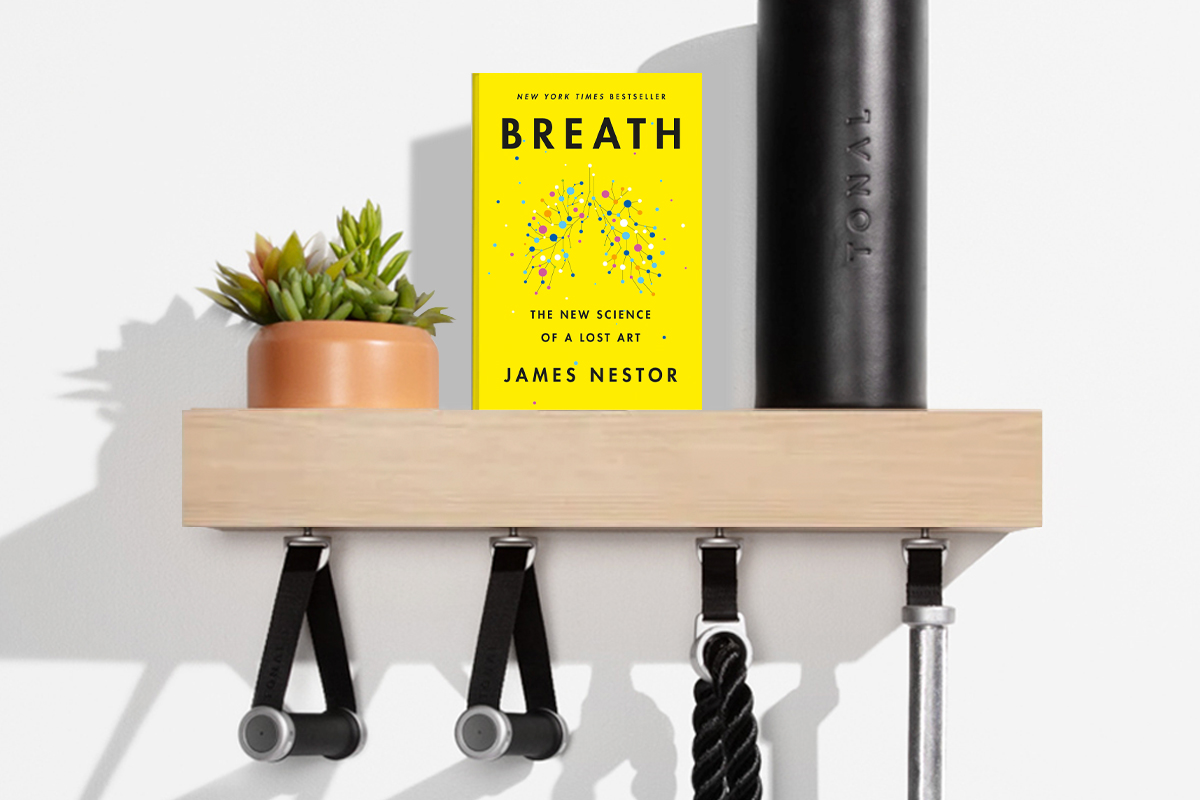Learn the right way to breathe in Breath, the August selection for Tonal’s official book club, Read Between the Reps.

Even though we take anywhere from 20,000 to 25,000 breaths each day, most of us don’t pay attention to our breathing unless something goes wrong—like bouts of asthma, snoring, or chronic sinus infections.
Science journalist James Nestor experienced this firsthand when he kept catching bronchitis and pneumonia.
“My doctor would just give me a bronchodilator or antibiotics and send me on my way. This went on for years and years,” he says in an interview with Tonal. “I talked to another doctor who suggested I could be breathing incorrectly and that I should go to a breathwork class.”
Nestor gave it a shot and was shocked to find that his respiratory issues disappeared.
This was the impetus for Nestor to dive into the study of breathing for his book, Breath: The New Science of a Lost Art, the August pick for Tonal’s book club, Read Between the Reps. He uncovered a wealth of knowledge, linking dysfunctional breathing to issues as wide-ranging as crooked teeth, sleep apnea, hypertension, and ADHD. “It doesn’t matter if you do everything else right with your sleep, exercise, and diet. You will never be healthy if your breathing is dysfunctional,” he says, “and the vast majority of us have dysfunctional breathing.”
In Breath, Nestor guides readers along a fascinating journey into the world of breathing and reveals how we can all improve our health by changing how we breathe.

Related story: How to Breathe Better to Boost Health and Performance
4 Essential Lessons You’ll Learn From Breath
1. We’ve Evolved Into Bad Breathers
Breathing problems like asthma and snoring are relatively new phenomena that are unique to modern humans. This is due to evolutionary changes that, over time, have shifted our physiology to make us less efficient at breathing. When humans transitioned from eating a diet of raw meat and plants to one of softer food that’s been cooked and tenderized, we were able to take in more calories, which went to growing bigger brains. As the human brain began to take up more space in the head, it forced the mouth and nose to compress, weakening the jaw and narrowing the airways.
For Nestor, this was one of the most shocking discoveries in his research. “I thought evolution always meant progress, right? We’re getting better and stronger and taller all the time. But just look at the average mouth and you’ll see this isn’t the case. Our mouths are so small that our teeth grow in crooked, and because we have small mouths, we have trouble breathing,” he says. “Even if we wanted to take healthy breaths, it’s very hard for most of us to do so because our faces have changed so dramatically.”
2. Nose Breathing is Best
Nestor becomes his own test subject in Breath when he asks a Stanford surgeon to plug up his nose for ten days, forcing him to breathe solely from his mouth. Tracking his health metrics over the course of the experiment, Nestor saw his blood pressure and heart rate increase, his snoring worsen, and his stress hormones spike. All of these metrics improved during the next 10 days when the plugs were removed and Nestor could breathe through his nose again.
By warming, moistening, and filtering the air we breathe, nasal breathing allows our bodies to process air more efficiently. Breathing through the nose also forces the airways to widen, making it easier to take in more air.
If you make just one change to your breathing after reading the book, Nestor stresses that this is the most important.
“More than 60 percent of the population breathes through their mouths when they’re sleeping. This is so deleterious to our health,” he says. He suggests putting a piece of tape over your mouth for 10 minutes each day (gradually working up to an hour and then wearing the tape at night as well) to train yourself to breath nasally.
“Some people completely transform their health by becoming obligate nasal breathers,” says Nestor. “In the animal kingdom, we’re the only ones that chronically default to mouth breathing and it’s causing us so much harm.”
3. Breathe Less
Even though most people breathe somewhere between 12 and 20 times per minute, Nestor’s research shows this is far more than optimum. Fast breathing can throw off the balance of oxygen and carbon dioxide in the blood. Letting carbon dioxide levels drop by taking in unnecessary air actually slows the process of delivering oxygenated blood to our muscles, tissues, and organs. In the book, Nestor compares your breathing rate to rowing a boat: “Taking a zillion short and stilted strokes will get you where you’re going, but they pale in comparison to the efficiency and speed of fewer, longer strokes.”
When studying different religions and traditions, Nestor found that Buddhist chants, Catholic prayer cycles, Hindi yoga chants, and other prayers among Taoist, Native American, and African cultures all followed a similar pattern: Inhale for 5.5 seconds, exhale for 5.5 seconds, breathing about 5.5 breaths per minute for a total of around 5.5 liters of air. Nestor calls this “perfect breathing,” and it’s easy to practice any time.
“When you breathe around that pattern, your heart rate synchronizes with your respiratory rate, your blood pressure often goes down, you feel extremely calm, and you get more oxygen to your brain,” says Nestor “All of the cells throughout your body are able to get oxygen more easily. This is how, biologically, our bodies work at their most efficient state.”
4. Sometimes, It’s Okay to Breathe More
Even though you should be breathing slowly most of the time, it can be beneficial to try overbreathing occasionally. Rapid breathing has been practiced across different cultures (Tibetan Buddhists call it Tummo, or “inner fire” breathing) and trains the body to better respond to stress.
This type of breathing activates the sympathetic nervous system, which triggers our fight or flight reaction.By intentionally creating this sensation, we learn to consciously control and turn off stress to feel calmer in everyday life. As Nestor writes, “Conscious heavy breathing teaches us to be the pilots of our autonomic nervous systems and our bodies, not the passengers.”
About the Book
To understand the science of breathing—and how we can do it better—journalist James Nestor ties together ancient wisdom, forgotten medical discoveries, and cutting edge research. His findings challenge the conventional wisdom on breathing and reveal surprisingly simple strategies that can boost health and performance. Breath was a New York Times bestseller and won the prize for Best General Nonfiction Book of 2020 by the American Society of Journalists and Authors.
About the Author
James Nestor is an author and journalist who has written for Scientific American, Outside Magazine, The New York Times, The Atlantic, and many more publications. His first book, Deep: Free Diving, Renegade Science, and What the Ocean Tells Us about Ourselves, delves into the fascinating world of freedivers who descend hundreds of feet into the ocean with a single breath.
How to Join Read Between the Reps
- Get a copy of Breath.
- Join the Tonal Book Club on Facebook.
- Join us in the book club Zoom on August 31 at 5 p.m., PT. Keep an eye on the Tonal Community board for more information.


